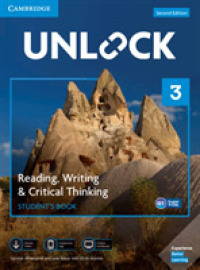Full Description
Statistics on the translation market consistently identify medicine as a major thematic area as far as volume or translation is concerned. Vicent Montalt and Maria Gonzalez Davis, both experienced translator trainers at Spanish universities, explain the basics of medical translation and ways of teaching and learning how to translate medical texts.
Medical Translation Step by Step provides a pedagogical approach to medical translation based on learner and learning-centred teaching tasks, revolving around interaction: pair and group work to carry out the tasks and exercises to practice the points covered. These include work on declarative and operative knowledge of both translation and medical texts and favour an approach that takes into account both the process and product of translations. Starting from a broad communication framework, the book follows a top-down approach to medical translation: communication → genres → texts → terms and other units of specialized knowledge. It is positively focused in that it does not insist on error analysis, but rather on ways of writing good translations and empowering both students and teachers.
The text can be used as a course book for students in face-to-face learning, but also in distance and mixed learning situations. It will also be useful for teachers as a resource book, or a core book to be complemented with other materials.
Contents
How to use this book: underlying principlesContents and structureTranslator training in a learner-centred environment1. Introduction to professional practiceOverview of chapter1.1 Historical overview of medical translation1.2 The specifics of medical translation1.3 Steps in the translation process1.4 Approaching the market1.5 Socializing with peers1.6 Becoming a medical translator: specific competencies1.7 Further tasks1.8 Further reading2. Understanding medical communicationOverview of chapter2.1 The dynamic and varied nature of medical communication2.2 Participants in medical communication and their communicative purposes2.3 Relationships among texts in written communication2.4 Articulating written communication through genres2.5 Some common medical genres2.6 Further tasks2.7 Further reading3. Understanding the content of the source textOverview of chapter3.1 How we understand texts3.2 Background medical knowledge3.3 Developing text comprehension strategies3.4 Further tasks3.5 Further reading4. Drafting the target textOverview of chapter4.1 Before starting to write4.2 A drafting methodology4.3 Composing the target text4.4 Crafting the target text4.5 Improving the draft4.6 Genre shift: Drafting heterofunctional translations4.7 Drafting research papers in English4.8 Further tasks4.9 Further reading5. Detecting and solving translation problemsOverview of chapter5.1 Describing problems, strategies, procedures and solutions5.2 Degrees of fidelity in translation5.3 Improving reading skills: spotting ambiguity5.4 Translating metaphors5.5 Transferring cultural references5.6 Transference skills: Written Protocols (WP)5.7 Facing problems in the production stage: writing5.8 Further tasks5.9 Further reading6. Using resources to solve problemsOverview of chapter6.1 Organizing yourself6.2 Starting up your own medical translation library6.3 Searching the web6.4 Using parallel texts6.5 Collaboration of subject matter experts and other translators6.6 Further tasks6.7 Further reading7. Dealing with terms and other units of specialized knowledgeOverview of chapter7.1 Terminologizing medical knowledge7.2 Greek and Latin basis of medical terms7.3 'In vitro' terminology: standardization7.4 'In vivo' terminology: variation7.5 De-terminologizing the text7.6 Further tasks7.7 Further readingAppendix 1. Translation problems: strategies, procedures and solutionsAppendix 2. Latin and Greek roots of medical terminologyReferencesIndex






